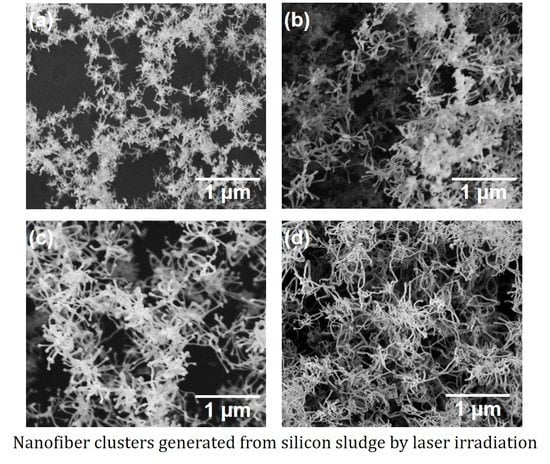Generating Silicon Nanofiber Clusters from Grinding Sludge by Millisecond Pulsed Laser Irradiation
Abstract
:1. Introduction
2. Materials and Methods
3. Results and Discussion
3.1. Effect of Gas Pressure
3.2. Effect of Laser Pulse Width
3.3. Effect of Sludge Oxidation Degree
3.4. Plume Generation Phenomenon
3.5. Mechanism of Nanofiber Cluster Formation
4. Conclusions
Author Contributions
Funding
Conflicts of Interest
References
- Yoko, A.; Oshima, Y. Recovery of silicon from silicon sludge using supercritical water. J. Supercrit. Fluids 2013, 75, 1–5. [Google Scholar] [CrossRef]
- Iwabuchi, Y.; Yan, J. Laser sintering of silicon powder and carbon nanofibers for porous composite thick films. Appl. Phys. Express 2015, 8, 026501. [Google Scholar] [CrossRef]
- Yan, J.; Okada, K. Fabrication of silicon-based porous nanocomposite films by focused infrared light sintering. CIRP Ann. Manuf. Technol. 2016, 65, 217–220. [Google Scholar] [CrossRef]
- Yan, J.; Noguchi, J.; Terashi, Y. Fabrication of single-crystal silicon micro pillars on copper foils by nanosecond pulsed laser irradiation. CIRP Ann. Manuf. Technol. 2017, 66, 253–256. [Google Scholar] [CrossRef]
- Chon, M.J.; Sethuraman, V.A.; Mccormick, A.; Srinivasan, V.; Guduru, P.R. Real-Time Measurement of Stress and Damage Evolution during Initial Lithiation of Crystalline Silicon. Phys. Rev. Lett. 2011, 107, 045503. [Google Scholar] [CrossRef]
- Dimitrijevic, B.J.; Aifantis, K.E.; Hackl, K. The influence of particle size and spacing on the fragmentation of nanocomposite anodes for Li batteries. J. Power Sources 2012, 206, 343–348. [Google Scholar] [CrossRef]
- Bencheikh, Y.; Harnois, M.; Jijie, R.; Addad, A.; Roussel, P.; Szunerits, S.; Hadjersi, T.; El Hak Abaidia, S.; Boukherroub, R. High performance silicon nanowires/ruthenium nanoparticles micro-supercapacitors. Electrochim. Acta 2019, 311, 150–159. [Google Scholar] [CrossRef]
- Sourice, J.; Bordes, A.; Boulineau, A.; Alper, J.P.; Franger, S.; Quinsac, A.; Habert, A.; Leconte, Y.; de Vito, E.; Porcher, W.; et al. Core-shell amorphous silicon-carbon nanoparticles for high performance anodes in lithium ion batteries. J. Power Sources 2016, 328, 527–535. [Google Scholar] [CrossRef]
- Hu, L.; Wu, H.; Sae Hong, S.; Cui, L.; McDonough, J.R.; Bohy, S.; Cui, Y. Si nanoparticle-decorated Si nanowire networks for Li-ion battery anodesw. Chem. Commun. 2011, 47, 367–369. [Google Scholar] [CrossRef]
- Latu-Romain, L.; Mouchet, C.; Cayron, C.; Rouviere, E.; Simonato, J.P. Growth parameters and shape specific synthesis of silicon nanowires by the VLS method. J. Nanopart. Res. 2008, 10, 1287–1291. [Google Scholar] [CrossRef]
- Tang, Y.H.; Zhang, Y.F.; Peng, H.Y.; Wang, N.; Lee, C.S.; Lee, S.T. Si nanowires synthesized by laser ablation of mixed SiC and SiO2 powders. Chem. Phys. Lett. 1999, 314, 16–20. [Google Scholar] [CrossRef]
- Wang, N.; Tang, Y.H.; Zhang, Y.F.; Yu, D.P.; Lee, C.S.; Bello, I.; Lee, S.T. Transmission electron microscopy evidence of the defect structure in Si nanowires synthesized by laser ablation. Chem. Phys. Lett. 1998, 283, 368–372. [Google Scholar] [CrossRef]
- Dimitrakopoulou, M.; Gorantla, S.; Thomas, J.; Gemming, T.; Cuniberti, G.; Büchner, B.; Rümmeli, M.H. Understanding the growth of amorphous SiO2 nanofibers and crystalline binary nanoparticles produced by laser ablation. Nanotechnology 2012, 23, 035601. [Google Scholar] [CrossRef] [PubMed] [Green Version]
- Kobayashi, K.; Kokai, F.; Sakurai, N.; Yasuda, H. Silicon-Catalyzed Growth of Amorphous SiO x Nanowires by Laser Vaporization of Si and Si/SiO2. J. Phys. Chem. C 2013, 117, 25169–25174. [Google Scholar] [CrossRef]
- Kokai, F.; Inoue, S.; Hidaka, H.; Uchiyama, K.; Takahashi, Y.; Koshio, A. Catalyst-free growth of amorphous silicon nanowires by laser ablation. Appl. Phys. A 2013, 112, 1–7. [Google Scholar] [CrossRef]
- Wang, N.; Tang, Y.H.; Zhang, Y.F.; Lee, C.S.; Bello, I.; Lee, S.T. Si nanowires grown from silicon oxide. Chem. Phys. Lett. 1999, 299, 237–242. [Google Scholar] [CrossRef]
- Ageev, E.I.; Potorochin, D.V.; Sachenko, D.V.; Odintsova, G.V. Generation of web-like structures and nanoparticles by femtosecond laser ablation of silicon target in ambient air. Opt. Quantum Electron. 2017, 49, 40. [Google Scholar] [CrossRef]
- Kashaev, F.V.; Kaminskaya, T.P.; Golovan, L.A. Structural properties of silicon nanoparticles obtained via femtosecond laser ablation in gases at different pressures. Opt. Quantum Electron. 2016, 48, 348. [Google Scholar] [CrossRef]
- Odo, E.A.; Faremi, A.A. Synthesis of silicon nanocomposite for printable photovoltaic devices on flexible substrate. J. Nanopart. Res. 2017, 19, 1–9. [Google Scholar] [CrossRef]
- Russo, L.; Colangelo, F.; Cioffi, R.; Rea, I.; de Stefano, L. A Mechanochemical Approach to Porous Silicon Nanoparticles Fabrication. Materials 2011, 4, 1023–1033. [Google Scholar] [CrossRef]
- Momoki, K.; Manabe, T.; Li, L.; Yan, J. Silicon nanoparticle generation and deposition on glass from waste silicon powder by nanosecond pulsed laser irradiation. Mater. Sci. Semicond. Process. 2020, 111. [Google Scholar] [CrossRef]
- Momoki, K.; Yan, J. Nanoparticle generation from various types of silicon materials by nanosecond-pulsed laser irradiation. Appl. Phys. Express 2020, 13, 026505. [Google Scholar] [CrossRef]
- Yoo, H.; Lee, J.-I.; Kim, H.; Lee, J.-P.; Cho, J.; Park, S. Helical Silicon/Silicon Oxide Core–Shell Anodes Grown onto the Surface of Bulk Silicon. Nano Lett. 2011, 11, 4324–4328. [Google Scholar] [CrossRef] [PubMed]
- Lee, J.; Koo, J.; Jang, B.; Kim, S. Quantitative relationships between microstructures and electrochemical properties in Si core-SiO x shell nanoparticles for Li-ion battery anodes. J. Power Sources 2016, 329, 79–87. [Google Scholar] [CrossRef]
- Chen, Y.; Liu, L.; Xiong, J.; Yang, T.; Qin, Y.; Yan, C. Porous Si Nanowires from Cheap Metallurgical Silicon Stabilized by a Surface Oxide Layer for Lithium Ion Batteries. Adv. Funct. Mater. 2015, 25, 6701–6709. [Google Scholar] [CrossRef]
- Kokai, F.; Sawada, N.; Hatano, K.; Koshio, A. Silicon-catalyzed growth of amorphous SiOx nanowires by continuous-wave laser ablation of SiO in high-pressure gas. Appl. Phy. A 2018, 124, 40. [Google Scholar] [CrossRef]
- Lim, K.W.; Lee, J.; Yang, J.; Kim, Y.; Jeong, H.Y.; Park, S.; Shin, H.S. Catalyst-Free Synthesis of Si-SiOx Core-Shell Nanowire Anodes for High-Rate and High-Capacity Lithium-Ion Batteries. ACS Appl. Mater. Interfaces 2014, 6, 6340–6345. [Google Scholar] [CrossRef]
- Li, Z.; He, Q.; He, L.; Hu, P.; Li, W.; Yan, H.; Peng, X.; Huang, C.; Mai, L. Self-sacrificed synthesis of carbon-coated SiOx nanowires for high capacity lithium ion battery anodes. J. Mater. Chem. A 2017, 5, 4183–4189. [Google Scholar] [CrossRef]
- Kanek, T.; Onisaw, K.I.; Wakagi, M.; Kita, Y.; Minemura, T. Crystalline fraction of microcrystalline silicon films prepared by plasma-enhanced chemical vapor deposition using pulsed silane flow. Jpn. J. Applied Phys. 1993, 32, 4907–4911. [Google Scholar] [CrossRef]
- Ma, Z.; Liao, X.; Zheng, W.; Yu, J.; Chu, J. Raman scattering and infrared absorption of silicon nanocrystals in silicon oxide matrix. Proc. SPIE 2000, 4086, 258–261. [Google Scholar]
- Han, D.; Lorentzen, J.D.; Weinberg-Wolf, J.; McNeil, L.E.; Wang, Q. Raman study of thin films of amorphous-to-microcrystalline silicon prepared by hot-wire chemical vapor deposition. J. Appl. Phys. 2003, 94, 2930–2936. [Google Scholar] [CrossRef]
- Palya, A.; Ranjbar, O.A.; Lin, Z.; Volkov, A.N. Kinetic simulations of laser-induced plume expansion into a background gas under conditions of spatial confinement. Int. J. Heat Mass Transfer 2019, 132, 1029–1052. [Google Scholar] [CrossRef]
- Tanaka, M.; Higashida, K.; Nakashima, H.; Takagi, H.; Fujiwara, M. Orientation dependence of fracture toughness measured by indentation methods and its relation to surface energy in single crystal silicon. Int. J. Fract. 2006, 139, 383–394. [Google Scholar] [CrossRef]
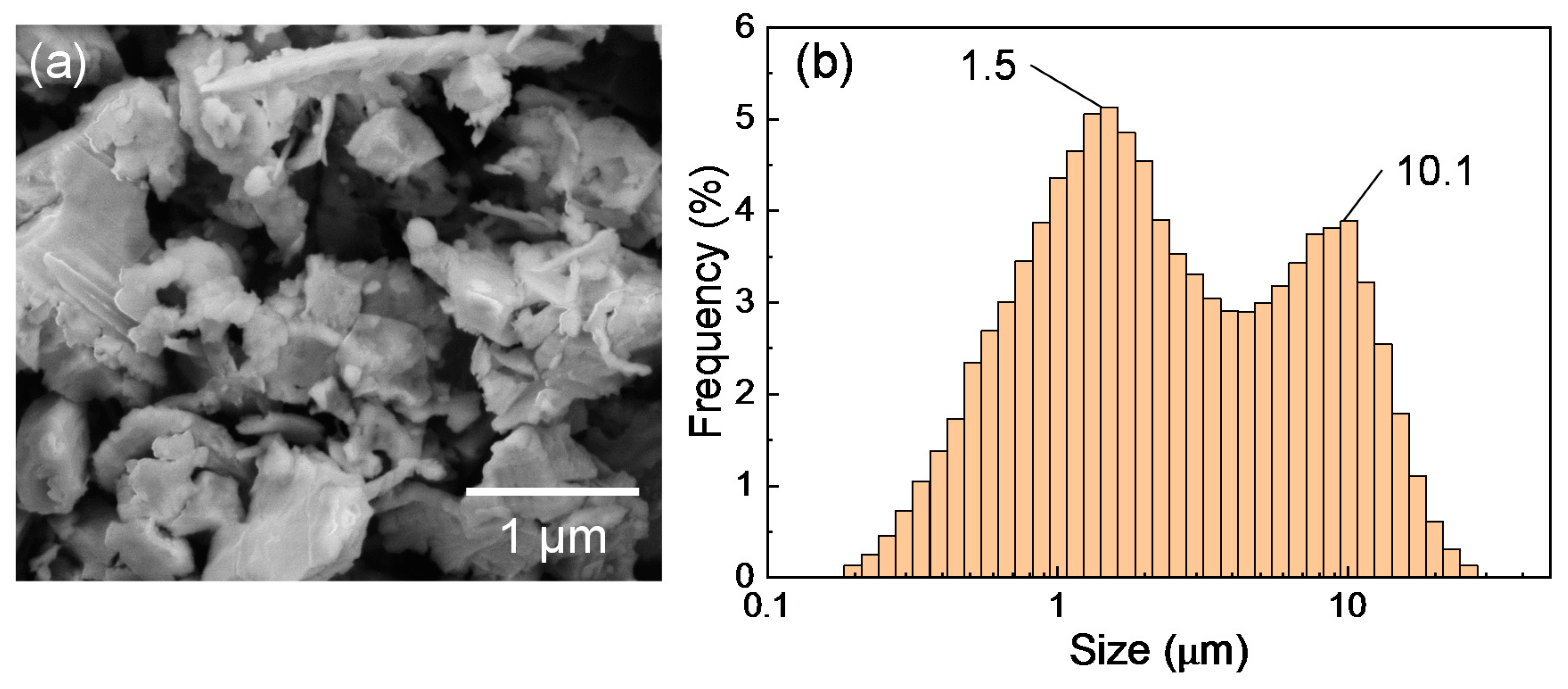
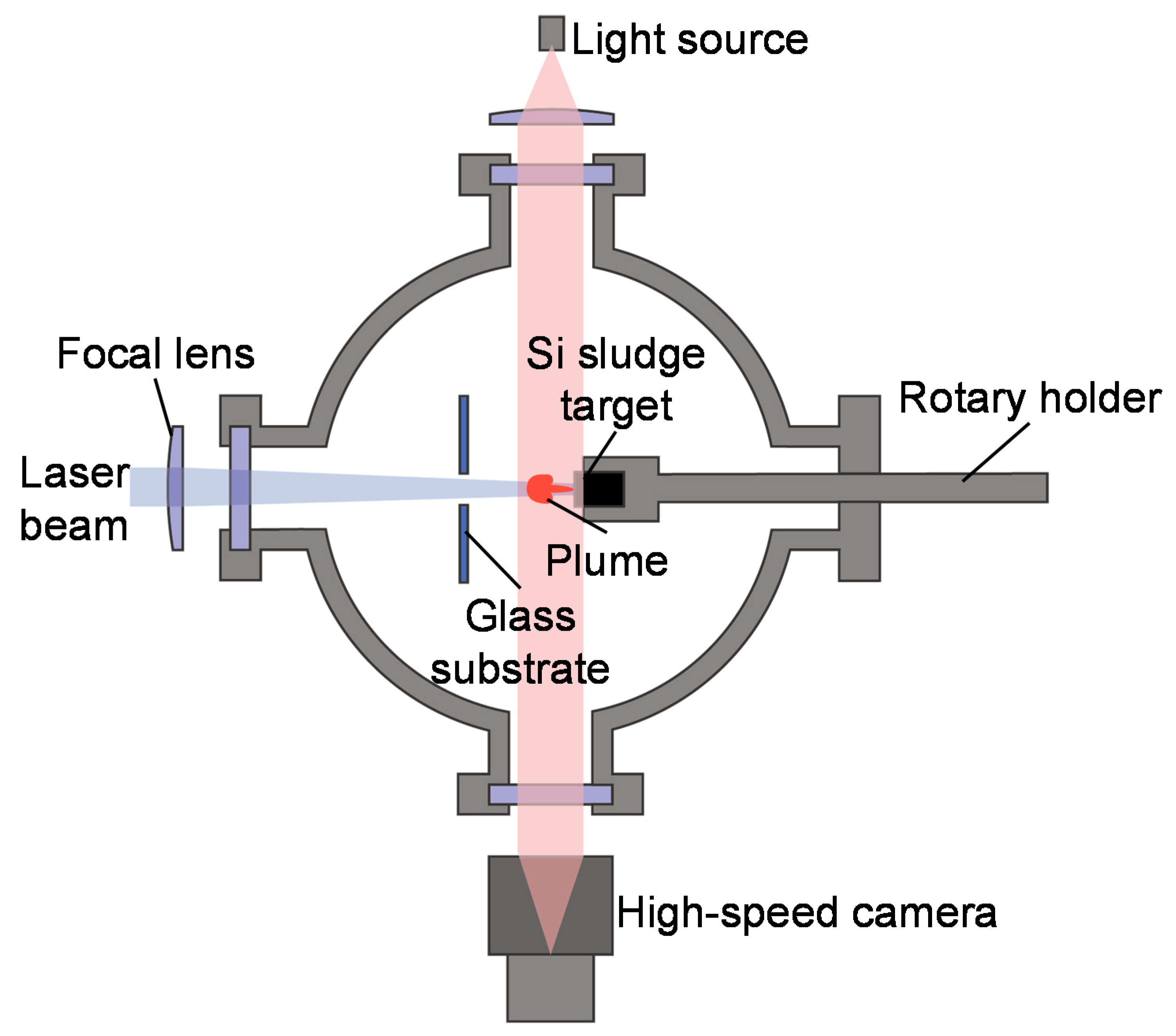

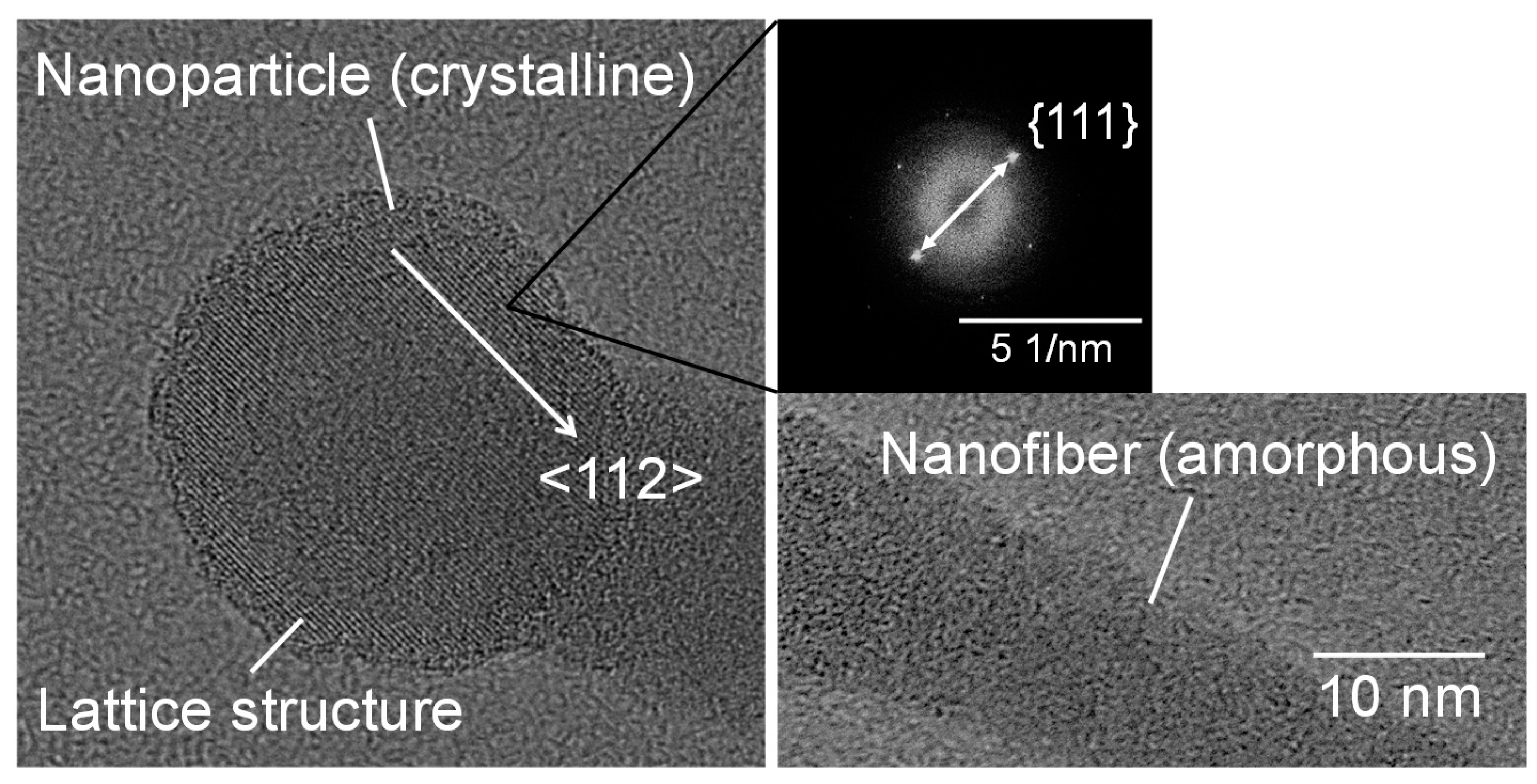
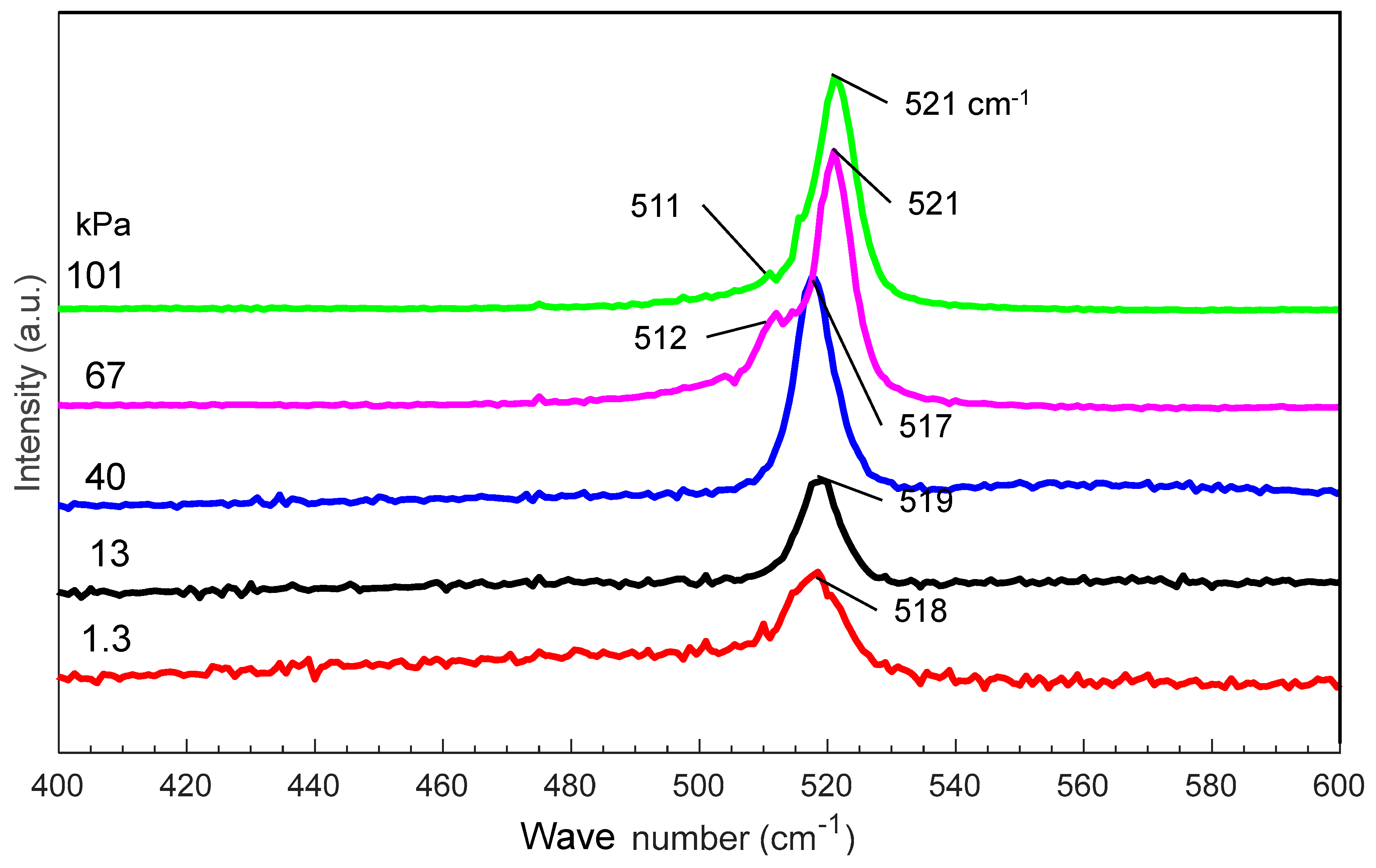

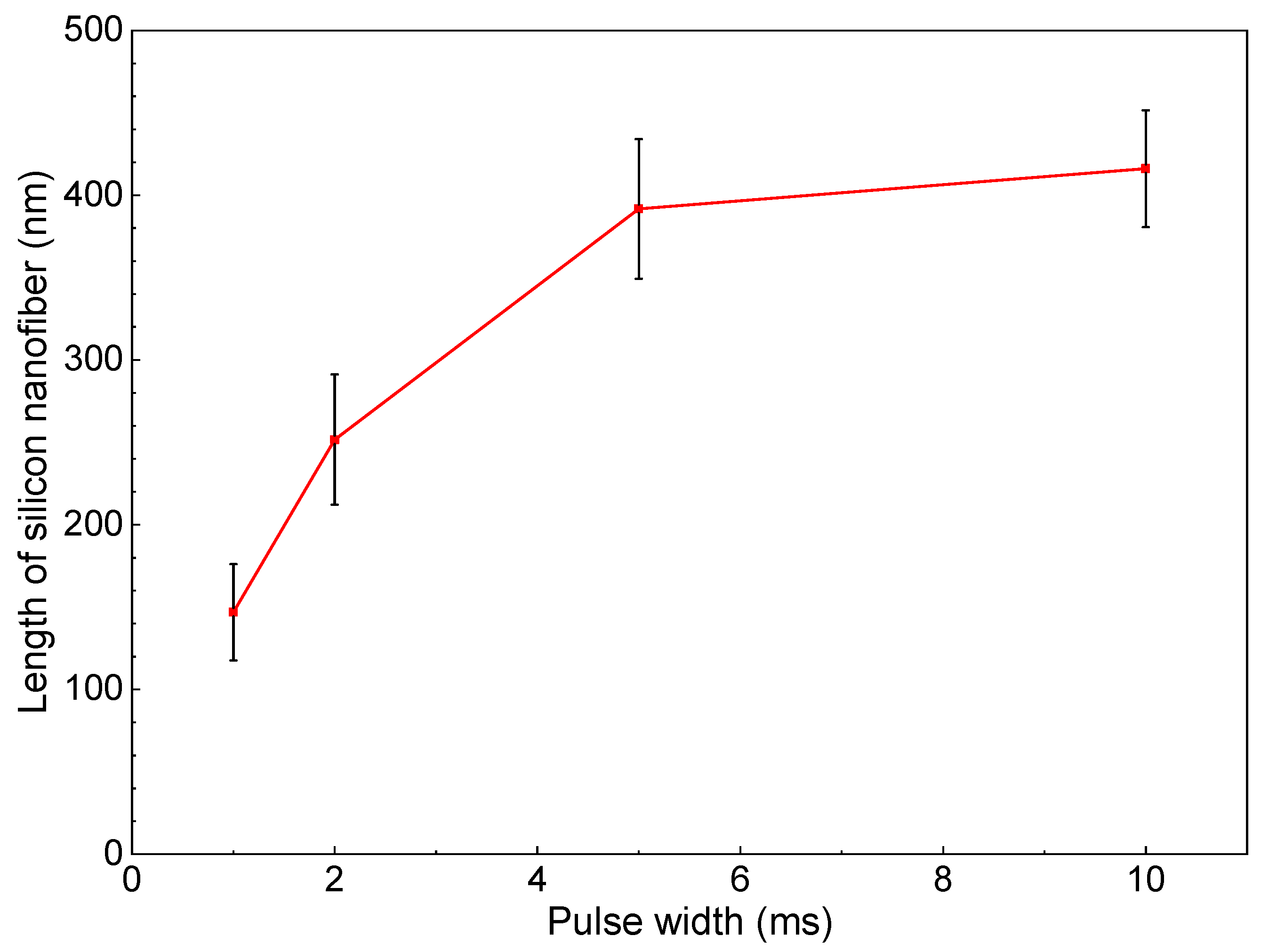

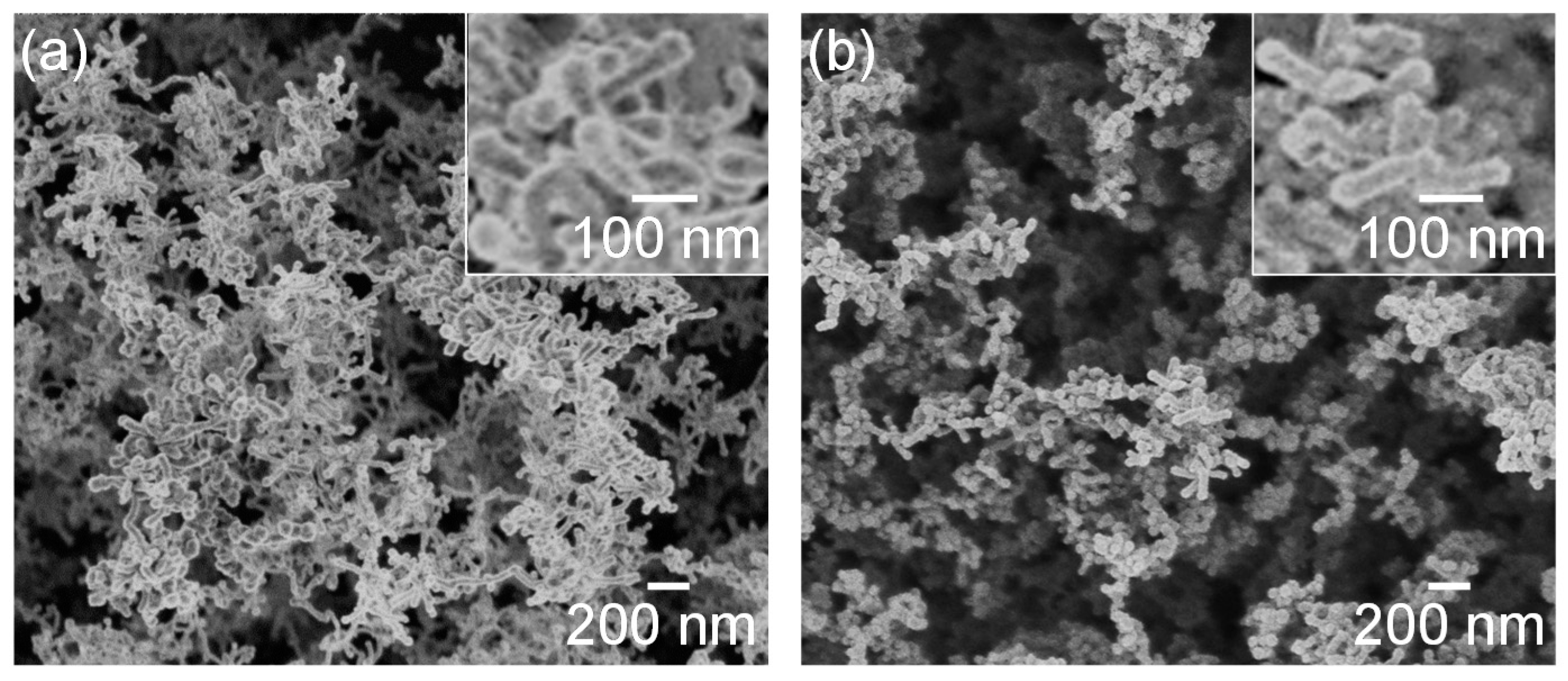

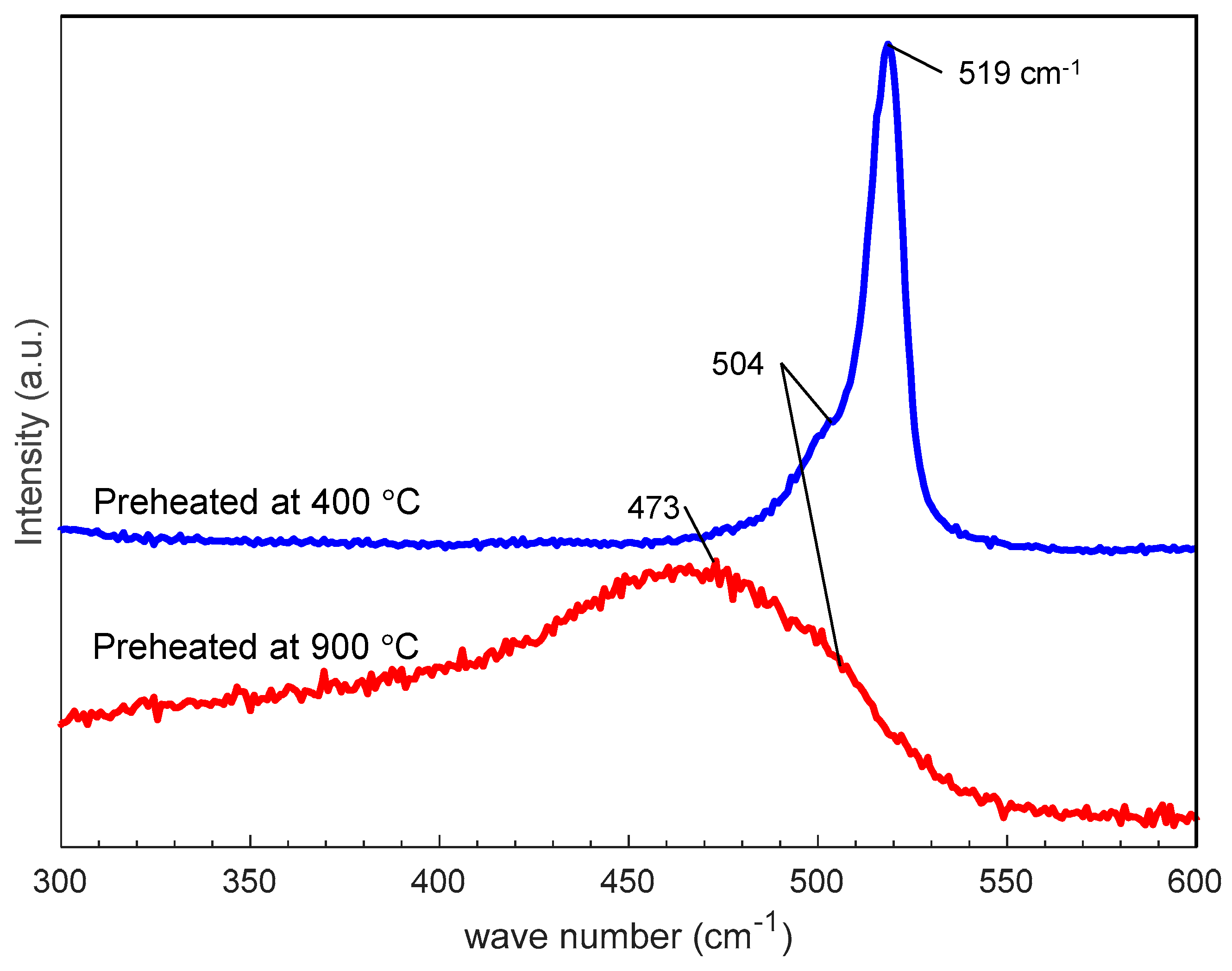
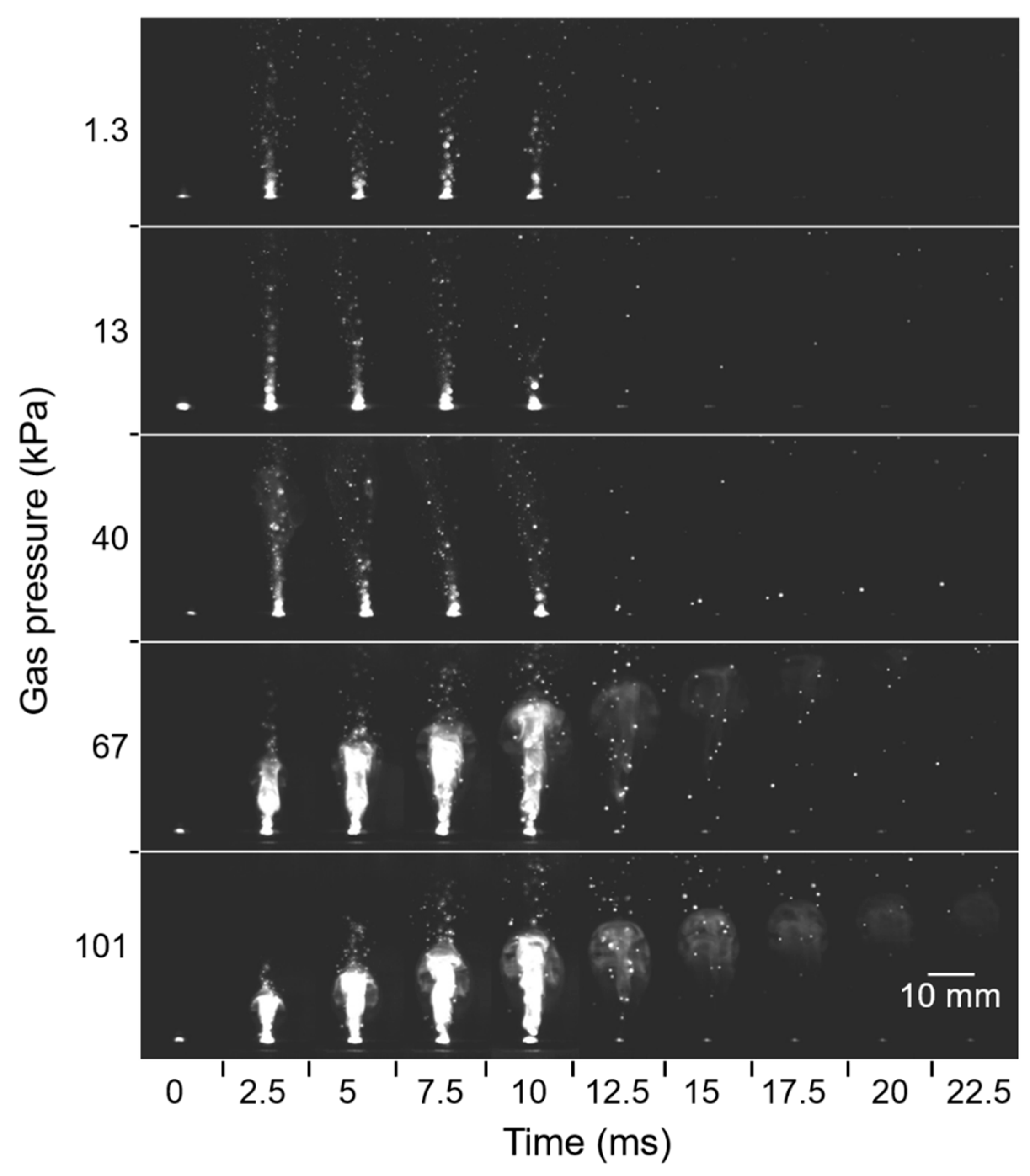

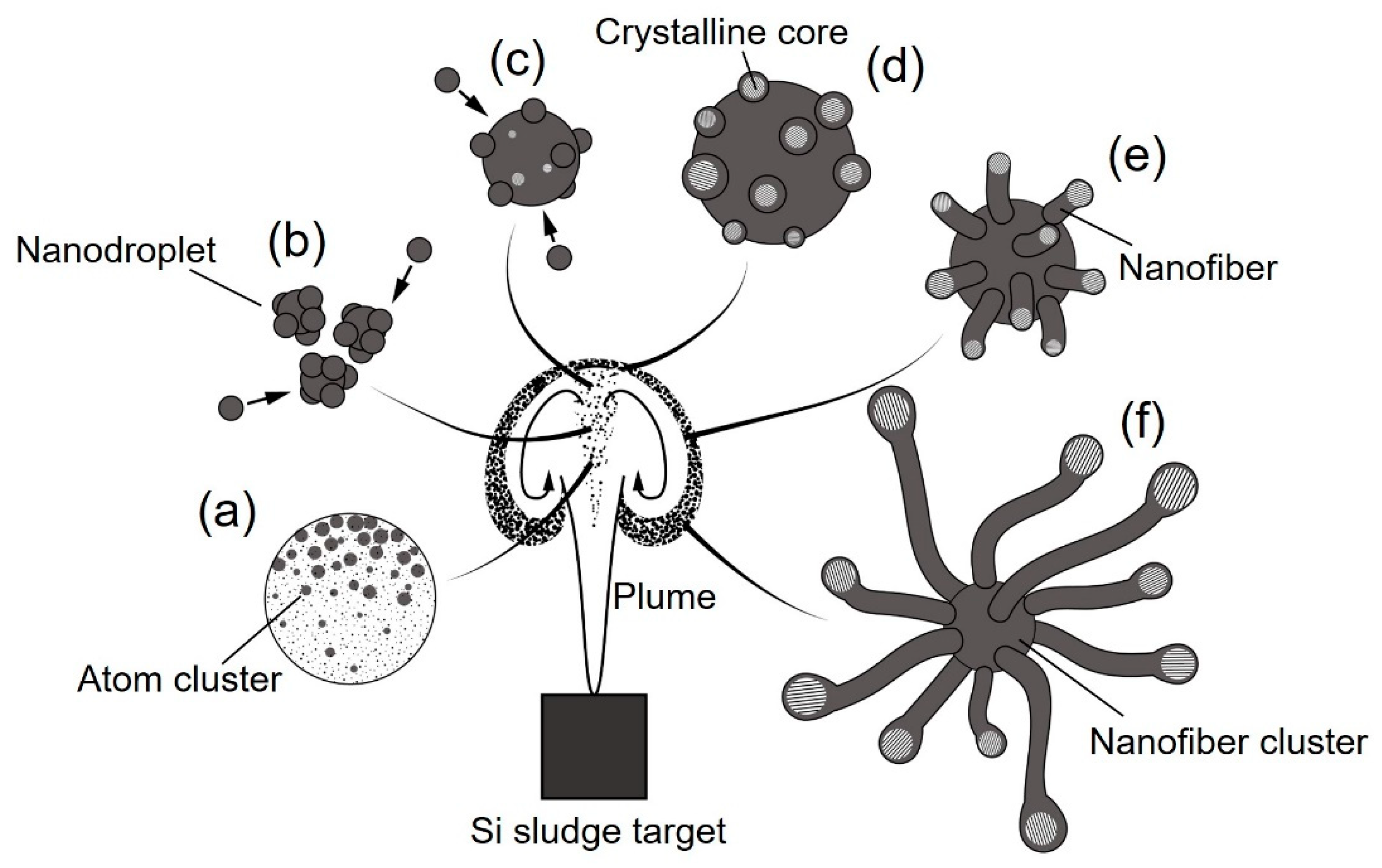
© 2020 by the authors. Licensee MDPI, Basel, Switzerland. This article is an open access article distributed under the terms and conditions of the Creative Commons Attribution (CC BY) license (http://creativecommons.org/licenses/by/4.0/).
Share and Cite
Momoki, K.; Takahashi, K.; Kobinata, K.; Kobayashi, Y.; Kawai, A.; Yan, J. Generating Silicon Nanofiber Clusters from Grinding Sludge by Millisecond Pulsed Laser Irradiation. Nanomaterials 2020, 10, 812. https://doi.org/10.3390/nano10040812
Momoki K, Takahashi K, Kobinata K, Kobayashi Y, Kawai A, Yan J. Generating Silicon Nanofiber Clusters from Grinding Sludge by Millisecond Pulsed Laser Irradiation. Nanomaterials. 2020; 10(4):812. https://doi.org/10.3390/nano10040812
Chicago/Turabian StyleMomoki, Ko, Kunimitsu Takahashi, Kyosuke Kobinata, Yoshikazu Kobayashi, Akihito Kawai, and Jiwang Yan. 2020. "Generating Silicon Nanofiber Clusters from Grinding Sludge by Millisecond Pulsed Laser Irradiation" Nanomaterials 10, no. 4: 812. https://doi.org/10.3390/nano10040812
APA StyleMomoki, K., Takahashi, K., Kobinata, K., Kobayashi, Y., Kawai, A., & Yan, J. (2020). Generating Silicon Nanofiber Clusters from Grinding Sludge by Millisecond Pulsed Laser Irradiation. Nanomaterials, 10(4), 812. https://doi.org/10.3390/nano10040812




